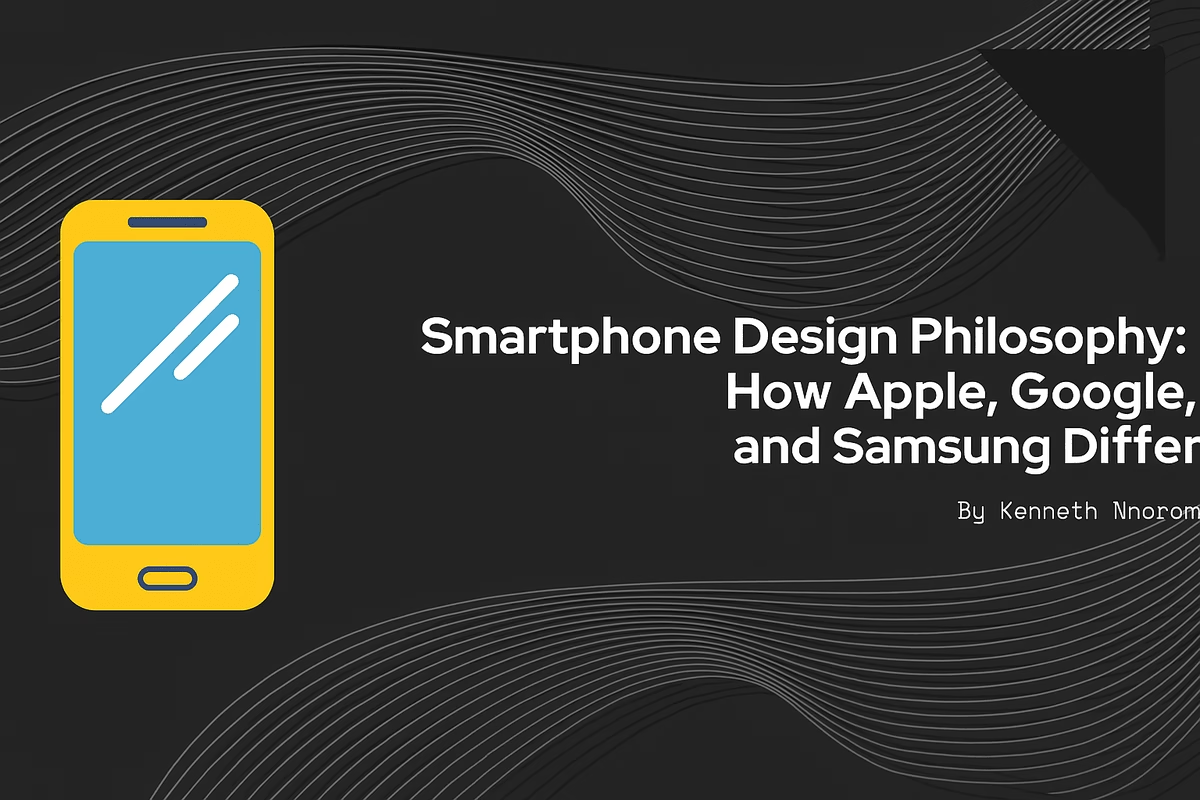In the high-stakes world of smartphones, three titans, Apple, Google, and Samsung, have taken starkly different paths to innovation, each with its own smartphone design philosophy. This has created a vibrant market where every approach has its place. This diversity gives us, the users, a real choice.
Apple’s Hardware-First Smartphone Design Philosophy
First, let’s discuss Apple. They recently launched the iPhone 17 event and finally decided to refresh the design. This was a needed move, a classic Apple play to give us all a reason to consider the new phone. Sticking to the old design wouldn’t have worked, especially since they were not exactly winning the software and AI war. The Verge astutely pointed out that their latest “consumer-facing AI tools”—like visual intelligence and live translation—are not novel. This confirmed my suspicion that Apple Intelligence’s first attempt last year was a miss, and its latest visual refresh is not as dynamic as what Android 17 brought to the table.
But Apple, ahead in SoC design for years, used that power to their advantage. Their A19 Pro is a monster, about 37% more powerful than the A18 Pro. The A18 Pro already puts them miles ahead of everyone else. This means they can leverage that chip to improve not just raw performance, but also their ISP pipeline and run on-device models. They can generally just perfect everything they have already figured out. The competition finds it extremely difficult to catch up. They also optimised the camera sensors and used them in ways I genuinely love, like the new square-shaped image sensor. The thermal efficiency they will get from the A19, thanks to that new heatsink, screams hardware perfection. It’s built to make already-good software even better. This is their chosen path, “hardware innovation,” and it has worked for them so far.
Beyond the raw specs, Apple also pushed significantly on the physical design. That new aluminium unibody frame makes the iPhone 17 lighter and more durable. They introduced Ceramic Shield 2 on both the front and back of the device, making it more resistant to scratches and giving it a more premium, polished feel. This kind of attention to materials and build quality ensures the phone is not just a high-performance tool, but a beautiful object. Their philosophy is a testament to holistic innovation, focusing on the experience from the moment you hold the device.
Google’s Software-First Smartphone Design Philosophy
Now, look at how Google has approached smartphones since the first Pixel launched. You can tell Google figured out they were behind in this race. To compete, they needed to use the one thing they are great at: software. They designed their phone with so much AI-based innovation that a regular user might never even notice the hardware gap between them and Apple or Samsung. This year’s Pixel 10 is a testament to that.
The Tensor G5 Chip and On-Device Models
It’s powered by the new Tensor G5 chip, which isn’t just a general-purpose processor. They built it as a custom-built AI engine with a Tensor Processing Unit (TPU) that’s 60% more powerful than its predecessor. This hardware is designed specifically to run Google’s on-device AI models like Gemini Nano with maximum efficiency. This makes it the first chip to run the newest Gemini Nano model. This enables many generative AI experiences to happen on the device.
This powerful hardware-software synergy allows for incredible new features. The new on-device Gemini Nano model runs 2.6x faster and twice as efficiently. This makes features like Magic Cue, Voice Translate, Pro Res Zoom, and the photo-to-video tool in the Gemini app feel a lot faster and smoother.
Deeper AI Integration
This year, Google also deeply integrated Gemini Live into core apps like Calendar, Keep, Tasks, and Google Maps. This makes it a breeze for you to check your schedules, create lists, or find places using natural voice conversations. The phone even allows for seamless multitasking. You can find directions while asking Gemini to call or message someone without breaking your conversation flow. The new model updates also give Gemini a more natural voice with better rhythm, pitch, and intonation. And for the first time, Gemini Live can use the camera to give you visual guidance. It recognizes what’s on screen and highlights useful details, which is perfect for you to troubleshoot problems or compare products in a store.
The perfect example of this is how Google approaches long-distance Zoom. While Samsung relies on a massive periscope lens and an incredible megapixel count to physically zoom in, Google’s “Super Res Zoom” and the new “Pro Res Zoom” on the Pixel 10 are all about computational photography. The phone snaps multiple frames and uses its powerful AI to fill in the missing details, remove noise, and sharpen the image. The result is often a more usable, clearer shot at extreme zoom levels. This is not because the lens is physically superior, but because the software is just that smart. This is a testament to their core philosophy: smarter software can also fix a problem that more powerful hardware can fix.
Samsung: The Master of All Trades
If Apple is about singular, polished hardware innovation and Google is about software-first smarts, Samsung has always tried to do everything at once. They consistently follow a “more is more” approach, packing their devices with every possible feature, from the S Pen to their foldable screens. They have always understood that a smartphone is a tool for everything from work to entertainment.
Hardware Excellence
This year’s Galaxy S25 Ultra is a perfect example. While Google focused on on-device AI and Apple pushed SoC efficiency, Samsung came out with a phone that is a true hardware beast. The S25 Ultra boasts a massive 200MP main camera sensor, complemented by an improved 50MP periscope telephoto lens with 5x optical zoom. This is not just about big numbers; it gives you a versatile tool that can handle every photography scenario you throw at it.
Galaxy AI: A Strategic Partnership
But the real story, the one that tells you Samsung is in this to win it, is in their strategic shift to AI. They no longer just build great hardware; they are layering on a complex and powerful AI suite that seamlessly integrates Google’s innovations. This is where the true “master of all trades” philosophy shines through. This isn’t about what’s under the hood, but how intelligently the car drives.
Samsung’s Galaxy AI is an intentional and deeply integrated part of the user experience on One UI. Features like Circle to Search with Google, which allows you to circle anything on your screen to get instant search results, result directly from this partnership. This is a game-changer because it makes information discovery so intuitive that you almost forget you are using two different companies’ technologies.
Beyond search, Samsung also introduced a suite of “Galaxy AI” features that are powered by a combination of their own models, like Samsung Gauss, and Google’s Gemini models. This hybrid approach ensures that some tasks, like offline translation and on-device photo editing, can happen without an internet connection for better privacy and speed. For more complex, cloud-based tasks, they leverage the full power of Gemini.
This strategic layering of AI is where Samsung forces the competition to keep up. While Google’s Pixel 10 might have the first-to-market advantage with new Gemini features, Samsung quickly follows and integrates these same tools into its own ecosystem. Take the new “Scroll and Translate” feature on Circle to Search; Samsung’s Galaxy phones got it first. This shows a very deliberate and tactical collaboration with Google that ensures Samsung is not left behind in the AI race.
The user benefits immensely from this. You are not forced to choose between the best hardware and the smartest software. With Samsung’s current approach, you can have both. It is a testament to their core philosophy: they deliver an all-encompassing package that anticipates user needs and builds the ecosystem to support it all. They understand that the future of smartphones is not just about raw power, but about the seamless synergy between hardware and intelligence.
The Verdict: Choosing the Right Smartphone for You
Ultimately, all three of these phones are high-end devices. It’s a testament to the competition that even the ones with a perceived hardware gap, like the Pixel, never feel like they’re lagging. It just goes to show that good software is as crucial as good hardware. As an engineer, you learn to look at product design with an open mind. You understand the trade-offs made and the smartphone design philosophy behind them. It’s a way to draw inspiration from other designers’ thought processes, regardless of their field. With that said, each of these phones is a masterpiece in its own right. The choice comes down to the kind of user you are.
The Samsung Galaxy is the phone for the power user who wants their device to be everything without compromises. It’s for the businessman who is also a gamer and loves to take great photos, someone who cannot afford delays or being locked into a single ecosystem. Features like DeX, which provide a desktop-like experience on a large screen, make it a versatile tool for both work and play.
The Apple iPhone Pro is best suited for content creators and those who need professional-grade control over their media. Its ability to shoot in raw video formats and export directly to an external SSD is a game-changer. The consistent quality of its photos and videos is a key selling point. You always know exactly what you’re going to get, which is invaluable for creative professionals.
The Google Pixel is the perfect fit for the user who just wants things to work effortlessly. They don’t want to think about the technical process; they just want a great result. Google’s AI optimises every detail, from perfecting a less-than-perfect photo to simplifying complex tasks. The bug-free, simple, and intuitive software experience makes it the phone for those who value convenience and a seamless user experience above all else.
In the end, it’s not about which phone is “best,” but about which one empowers you to do what you do best.


Leave a Reply